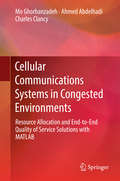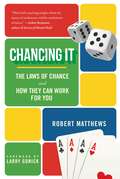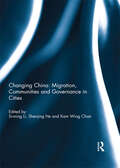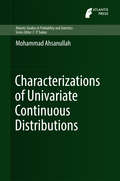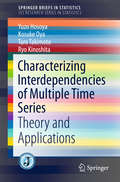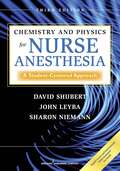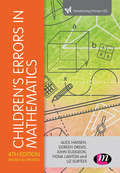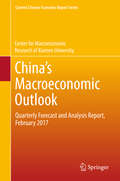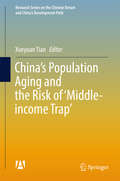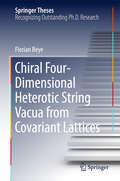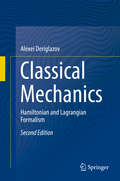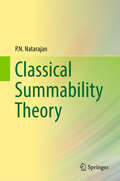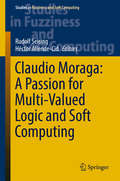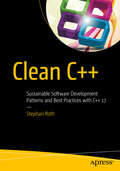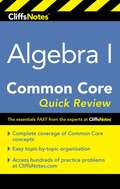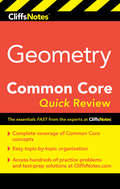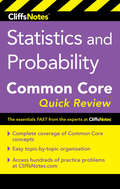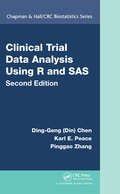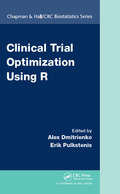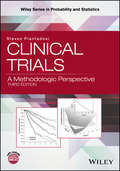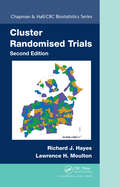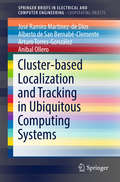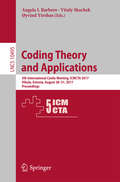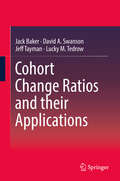- Table View
- List View
Cellular Communications Systems in Congested Environments: Resource Allocation and End-to-End Quality of Service Solutions with MATLAB
by Ahmed Abdelhadi Mo Ghorbanzadeh Charles ClancyThis book presents a mathematical treatment of the radio resource allocation of modern cellular communications systems in contested environments. It focuses on fulfilling the quality of service requirements of the living applications on the user devices, which leverage the cellular system, and with attention to elevating the users' quality of experience. The authors also address the congestion of the spectrum by allowing sharing with the band incumbents while providing with a quality-of-service-minded resource allocation in the network. The content is of particular interest to telecommunications scheduler experts in industry, communications applications academia, and graduate students whose paramount research deals with resource allocation and quality of service.
Chancing It: The Laws of Chance and How They Can Work for You
by Robert MatthewsMake your own luck by understanding probabilityOver the years, some very smart people have thought they understood the rules of chance?only to fail dismally. Whether you call it probability, risk, or uncertainty, the workings of chance often defy common sense. Fortunately, advances in math and science have revealed the laws of chance, and understanding those laws can help in your everyday life.In Chancing It, award-winning scientist and writer Robert Matthews shows how to understand the laws of probability and use them to your advantage. He gives you access to some of the most potent intellectual tools ever developed and explains how to use them to guide your judgments and decisions. By the end of the book, you will know:How to understand and even predict coincidencesWhen an insurance policy is worth havingWhy “expert” predictions are often misleadingHow to tell when a scientific claim is a breakthrough or baloneyWhen it makes sense to place a bet on anything from sports to stock marketsA groundbreaking introduction to the power of probability, Chancing It will sharpen your decision-making and maximize your luck.
Changing China: Migration, Communities and Governance in Cities
by Si-ming Li, Shenjing He and Kam Wing ChanChina’s unprecedented urbanization is underpinned by not only massive rural-urban migration but also a household registration system embedded in a territorial hierarchy that produces lingering urban-rural duality. The mid-1990s onwards witnessed increasing reliance on land revenues by municipal governments, causing repeated redrawing of city boundaries to incorporate surrounding countryside. The identification of real estate as a growth anchor further fueled urban expansion. Sprawling commodity housing estates proliferate on urban-rural fringes, juxtaposed with historical villages undergoing intense densification. The traditional urban core and work-unit compounds also undergo wholesale redevelopment. Alongside large influx of migrants, major reshuffling of population has taken place inside metropolitan areas. Chinese cities today are more differentiated than ever, with new communities superimposing and superseding older ones. The rise of the urban middle class, in particular, has facilitated the formation of homeowners’ associations, and poses major challenges to hitherto state dominated local governance.The present volume tries to more deeply unravel and delineate the intertwining forms and processes outlined above from a variety of angles: circulatory, mobility and precariousness; urbanization, diversity and segregation; and community and local governance. Contributors include scholars of Chinese cities from mainland China, Hong Kong, Canada, Australia and the United States. This volume was previously published as a special issue of Eurasian Geography and Economics.
Characterizations of Univariate Continuous Distributions (Atlantis Studies in Probability and Statistics #7)
by Mohammad AhsanullahProvides in an organized manner characterizations of univariate probability distributions with many new results published in this area since the 1978 work of Golambos & Kotz "Characterizations of Probability Distributions" (Springer), together with applications of the theory in model fitting and predictions.
Characterizing Interdependencies of Multiple Time Series: Theory and Applications (SpringerBriefs in Statistics)
by Yuzo Hosoya Kosuke Oya Taro Takimoto Ryo KinoshitaThis book introduces academic researchers and professionals to the basic concepts and methods for characterizing interdependencies of multiple time series in the frequency domain. Detecting causal directions between a pair of time series and the extent of their effects, as well as testing the non existence of a feedback relation between them, have constituted major focal points in multiple time series analysis since Granger introduced the celebrated definition of causality in view of prediction improvement. Causality analysis has since been widely applied in many disciplines. Although most analyses are conducted from the perspective of the time domain, a frequency domain method introduced in this book sheds new light on another aspect that disentangles the interdependencies between multiple time series in terms of long-term or short-term effects, quantitatively characterizing them. The frequency domain method includes the Granger noncausality test as a special case. Chapters 2 and 3 of the book introduce an improved version of the basic concepts for measuring the one-way effect, reciprocity, and association of multiple time series, which were originally proposed by Hosoya. Then the statistical inferences of these measures are presented, with a focus on the stationary multivariate autoregressive moving-average processes, which include the estimation and test of causality change. Empirical analyses are provided to illustrate what alternative aspects are detected and how the methods introduced here can be conveniently applied. Most of the materials in Chapters 4 and 5 are based on the authors' latest research work. Subsidiary items are collected in the Appendix.
Chemistry and Physics for Nurse Anesthesia: A Student-Centered Approach
by David Shubert John Leyba Sharon NiemannWith a focus on chemistry and physics content that is directly relevant to the practice of anesthesia, this text--written in an engaging, conversational style--supplies all the scientific information required for the combined chemistry and physics course for nurse anesthesia students. Now in its third edition, the text is updated and reorganized to facilitate a greater ease and depth of understanding. The addition of a third author--a practicing nurse anesthetist--enhances the clinical relevance of the scientific information. Clinical scenarios now begin every chapter, and a concluding chapter, new to this edition, provides detailed, step-by-step solutions to the book's review questions. Also included is a comprehensive list of need-to-know equations. <P><P>The third edition retains the many outstanding learning features from earlier editions, including a special focus on gases, the use of illustrations to demonstrate how scientific concepts relate directly to their clinical application in anesthesia, and end-of-chapter summaries and review questions to facilitate self-assessment. Fifteen online videos enhance teaching and learning, and abundant clinical application scenarios help reinforce scientific principles and relate them to day-to-day anesthesia procedures. This clear, easy-to-read text will help even the most chemistry- and physics-phobic students to master the foundations of these sciences and competently apply them in a variety of clinical situations.
Children's Errors in Mathematics: Understanding Common Misconceptions In Primary Schools (Transforming Primary QTS Series)
by Alice Hansen John Dudgeon Doreen Drews Liz Surtees Fiona LawtonThis practical and popular guide to children’s common errors and misconceptions in primary mathematics is an essential tool for teachers and trainees. It supports them in planning for and tackling potential errors and enhances their understanding of the difficulties encountered in mathematical development. This fourth edition explores how a Growth Mindset approach works alongside an awareness of children's errors and how mistakes themselves are powerful learning tools. This edition includes 50 new identifiable misconceptions children have of mathematics. The text also considers the role of the teacher in understanding and addressing children’s common mathematical misconceptions. Key features: Linked to the new National Curriculum and covers every objective Provides an essential tool for planning primary mathematics lessons Explores how common misconceptions can be anticipated and addressed
China’s Macroeconomic Outlook: Quarterly Forecast and Analysis Report, February 2017 (Current Chinese Economic Report Series)
by Center for Macroeconomic Research of Xiamen UniversityThis book is a quarterly forecast and analysis report on the Chinese economy. It is published twice a year and presents ongoing results from the "China Quarterly Macroeconomic Model (CQMM)," a research project at the Center for Macroeconomic Research (CMR) at Xiamen University. Based on the CQMM, the research team forecasts China's major macroeconomic indicators for the next 8 quarters, including GDP growth rate, CPI, PPI, investment in fixed assets, household consumption, imports, exports, and foreign reserves. Moreover, it simulates different scenarios to study the effects of macroeconomic policy on the Chinese economy. In addition to helping readers to understand China's economic trends and policies, this book has three main goals: to help readers understand China's economic performance; to forecast the major macroeconomic indicators for the next 8 quarters; and to simulate the effectiveness of macroeconomic policy.
China’s Population Aging and the Risk of ‘Middle-income Trap’ (Research Series on the Chinese Dream and China’s Development Path)
by Xueyuan TianThis book includes a series of reports that mainly discuss the Middle Income Trap against the backdrop of population ageing in China. It also offers practical suggestions on how to avoid it properly. Concretely, it argues that the government should accelerate the transition of economic development modes, resolve concentrated social conflicts, promote a balanced rural and urban development during the process of urbanization, and mitigate the effects of population ageing by fostering strengths and avoiding weaknesses. As for the challenges posed by population ageing in China, it puts forward five core suggestions tailored to China's unique situation. Assessing a number of real-world challenges, the general report and the special reports combine theory and empirical findings, using primary data for their analyses. Given the wealth of essential information it provides, the book offers a valuable reference resource for decision-makers.
Chiral Four-Dimensional Heterotic String Vacua from Covariant Lattices (Springer Theses)
by Florian BeyeThis book is placed at the interface between string theory and elementary particle physics and shows novel results in the search for a heterotic string vacuum that reproduces those matter particles and interactions observed in our universe. The author provides a systematic classification of potentially realistic heterotic covariant lattice vacua, which possess a lower number of moduli fields when compared to conventional compactification methods, by means of number theoretical methods. These methods, while well known to the mathematics community, have not yet found many applications to physics. They are introduced to the degree necessary to understand the computations carried out throughout this work. Furthermore, explicit covariant lattice models with particularly interesting properties are analyzed in detail. Finally, new light is shed on the relation between covariant lattice models and asymmetric orbifold compactifications, the result being a concrete correspondence between certain types of asymmetric orbifolds and those classified covariant lattices.
Classical Mechanics: Hamiltonian and Lagrangian Formalism
by Alexei DeriglazovThe revised edition of this advanced textbook provides the reader with a solid grounding in the formalism of classical mechanics, underlying a number of powerful mathematical methods that are widely used in modern theoretical and mathematical physics. It reviews the fundamentals of Lagrangian and Hamiltonian mechanics, and goes on to cover related topics such as canonical transformations, integral invariants, potential motion in geometric setting, symmetries, the Noether theorem and systems with constraints. While in some cases the formalism is developed beyond the traditional level adopted in the standard textbooks on classical mechanics, only elementary mathematical methods are used in the exposition of the material. New material for the revised edition includes additional sections on the Euler-Lagrange equation, the Cartan two-form in Lagrangian theory, and Newtonian equations of motion in context of general relativity. Also new for this edition is the inclusion of problem sets and solutions to aid in the understanding of the material presented. The mathematical constructions involved are explicitly described and explained, so the book is a good starting point for the student new to this field. Where possible, intuitive motivations are replaced by explicit proofs and direct computations, preserving the level of rigor that makes the book useful for more advanced students intending to work in one of the branches of the vast field of theoretical physics. To illustrate how classical-mechanics formalism works in other branches of theoretical physics, examples related to electrodynamics, as well as to relativistic and quantum mechanics, are included.
Classical Summability Theory
by P. N. NatarajanThis book presents results about certain summability methods, such as the Abel method, the Norlund method, the Weighted mean method, the Euler method and the Natarajan method, which have not appeared in many standard books. It proves a few results on the Cauchy multiplication of certain summable series and some product theorems. It also proves a number of Steinhaus type theorems. In addition, it introduces a new definition of convergence of a double sequence and double series and proves the Silverman-Toeplitz theorem for four-dimensional infinite matrices, as well as Schur's and Steinhaus theorems for four-dimensional infinite matrices. The Norlund method, the Weighted mean method and the Natarajan method for double sequences are also discussed in the context of the new definition. Divided into six chapters, the book supplements the material already discussed in G. H. Hardy's Divergent Series. It appeals to young researchers and experienced mathematicians who wish to explore new areas in Summability Theory. .
Claudio Moraga: A Passion for Multi-Valued Logic and Soft Computing (Studies in Fuzziness and Soft Computing #349)
by Rudolf Seising Héctor Allende-CidThe book is an authoritative collection of contributions by leading experts on the topics of fuzzy logic, multi-valued logic and neural network. Originally written as an homage to Claudio Moraga, seen by his colleagues as an example of concentration, discipline and passion for science, the book also represents a timely reference guide for advance students and researchers in the field of soft computing, and multiple-valued logic.
Clean C++: Sustainable Software Development Patterns and Best Practices with C++ 17
by Stephan RothWrite maintainable, extensible, and durable software with modern C++. This book is a must for every developer, software architect, or team leader who is interested in good C++ code, and thus also wants to save development costs. If you want to teach yourself about writing clean C++, Clean C++ is exactly what you need. It is written to help C++ developers of all skill levels and shows by example how to write understandable, flexible, maintainable, and efficient C++ code. Even if you are a seasoned C++ developer, there are nuggets and data points in this book that you will find useful in your work. If you don't take care with your code, you can produce a large, messy, and unmaintainable beast in any programming language. However, C++ projects in particular are prone to be messy and tend to slip into bad habits. Lots of C++ code that is written today looks as if it was written in the 1980s. It seems that C++ developers have been forg otten by those who preach Software Craftsmanship and Clean Code principles. The Web is full of bad, but apparently very fast and highly optimized C++ code examples, with cruel syntax that completely ignores elementary principles of good design and well-written code. This book will explain how to avoid this scenario and how to get the most out of your C++ code. You'll find your coding becomes more efficient and, importantly, more fun. What You'll Learn Gain sound principles and rules for clean coding in C++ Carry out test driven development (TDD) Discover C++ design patterns and idioms Apply these design patterns Who This Book Is For Any C++ developer and software engineer with an interest in producing better code.
CliffsNotes Algebra I Common Core Quick Review
by Kimberly GoresA quick in, quick out review of Algebra I Common Core math Relevant to high school students enrolled in their Algebra I class in those states adhering to the Common Core math standards, this quick review provides targeted chapter-level reviews of topics aligned to the Algebra I Common Core math standards, with practice problems throughout each review chapter and chapter-end quizzes. This quick review is supplemented with 300+ multiple-choice questions available on CliffsNotes.com.
CliffsNotes Geometry Common Core Quick Review
by M. Sunil KoswattaA quick in, quick out review of Geometry Common Core math Relevant to high school students enrolled in their Geometry class in those states adhering to the Common Core math standards, this quick review provides targeted chapter-level reviews of topics aligned to the Geometry Common Core math standards. The lessons are reinforced with practice problems throughout each chapter as well as chapter-end quizzes. This quick review is supplemented with 300+ multiple-choice questions available on CliffsNotes.com.
CliffsNotes Statistics and Probability Common Core Quick Review
by Malihe AlikhaniA quick in, quick out review of Statistics and Probability Common Core math? Relevant to high school students needing to review the Statistics and Probability component of the Common Core math standards, this quick review provides targeted chapter-level reviews of topics aligned to the Statistics and Probability Common Core math standards, with practice problems throughout each review chapter and chapter-end quizzes. This quick review is supplemented with 300+ multiple-choice questions available on CliffsNotes.com.
Clinical Coding Workout 2017: Practice Exercises for Skill Development with Odd-Numbered Online Answers
by American Medical AssociationClinical Coding Workout: Practice Exercises for Skill Development, with Odd-numbered Online Answers
Clinical Trial Data Analysis Using R and SAS (Chapman & Hall/CRC Biostatistics Series)
by Ding-Geng Chen Pinggao Zhang Karl PeaceReview of the First Edition "The goal of this book, as stated by the authors, is to fill the knowledge gap that exists between developed statistical methods and the applications of these methods. Overall, this book achieves the goal successfully and does a nice job. I would highly recommend it …The example-based approach is easy to follow and makes the book a very helpful desktop reference for many biostatistics methods."—Journal of Statistical Software Clinical Trial Data Analysis Using R and SAS, Second Edition provides a thorough presentation of biostatistical analyses of clinical trial data with step-by-step implementations using R and SAS. The book’s practical, detailed approach draws on the authors’ 30 years’ experience in biostatistical research and clinical development. The authors develop step-by-step analysis code using appropriate R packages and functions and SAS PROCS, which enables readers to gain an understanding of the analysis methods and R and SAS implementation so that they can use these two popular software packages to analyze their own clinical trial data. What’s New in the Second Edition Adds SAS programs along with the R programs for clinical trial data analysis. Updates all the statistical analysis with updated R packages. Includes correlated data analysis with multivariate analysis of variance. Applies R and SAS to clinical trial data from hypertension, duodenal ulcer, beta blockers, familial andenomatous polyposis, and breast cancer trials. Covers the biostatistical aspects of various clinical trials, including treatment comparisons, time-to-event endpoints, longitudinal clinical trials, and bioequivalence trials.
Clinical Trial Optimization Using R (Chapman & Hall/CRC Biostatistics Series)
by Alex Dmitrienko; Erik PulkstenisClinical Trial Optimization Using R explores a unified and broadly applicable framework for optimizing decision making and strategy selection in clinical development, through a series of examples and case studies. It provides the clinical researcher with a powerful evaluation paradigm, as well as supportive R tools, to evaluate and select among simultaneous competing designs or analysis options. It is applicable broadly to statisticians and other quantitative clinical trialists, who have an interest in optimizing clinical trials, clinical trial programs, or associated analytics and decision making. This book presents in depth the Clinical Scenario Evaluation (CSE) framework, and discusses optimization strategies, including the quantitative assessment of tradeoffs. A variety of common development challenges are evaluated as case studies, and used to show how this framework both simplifies and optimizes strategy selection. Specific settings include optimizing adaptive designs, multiplicity and subgroup analysis strategies, and overall development decision-making criteria around Go/No-Go. After this book, the reader will be equipped to extend the CSE framework to their particular development challenges as well.
Clinical Trials: A Methodologic Perspective
by Steven PiantadosiPresents elements of clinical trial methods that are essential in planning, designing, conducting, analyzing, and interpreting clinical trials with the goal of improving the evidence derived from these important studies This Third Edition builds on the text's reputation as a straightforward, detailed, and authoritative presentation of quantitative methods for clinical trials. Readers will encounter the principles of design for various types of clinical trials, and are then skillfully guided through the complete process of planning the experiment, assembling a study cohort, assessing data, and reporting results. Throughout the process, the author alerts readers to problems that may arise during the course of the trial and provides common sense solutions. All stages of therapeutic development are discussed in detail, and the methods are not restricted to a single clinical application area. The authors bases current revisions and updates on his own experience, classroom instruction, and feedback from teachers and medical and statistical professionals involved in clinical trials. The Third Edition greatly expands its coverage, ranging from statistical principles to new and provocative topics, including alternative medicine and ethics, middle development, comparative studies, and adaptive designs. At the same time, it offers more pragmatic advice for issues such as selecting outcomes, sample size, analysis, reporting, and handling allegations of misconduct. Readers familiar with the First and Second Editions will discover revamped exercise sets; an updated and extensive reference section; new material on endpoints and the developmental pipeline, among others; and revisions of numerous sections. In addition, this book: * Features accessible and broad coverage of statistical design methods--the crucial building blocks of clinical trials and medical research -- now complete with new chapters on overall development, middle development, comparative studies, and adaptive designs * Teaches readers to design clinical trials that produce valid qualitative results backed by rigorous statistical methods * Contains an introduction and summary in each chapter to reinforce key points * Includes discussion questions to stimulate critical thinking and help readers understand how they can apply their newfound knowledge * Provides extensive references to direct readers to the most recent literature, and there are numerous new or revised exercises throughout the book Clinical Trials: A Methodologic Perspective, Third Edition is a textbook accessible to advanced undergraduate students in the quantitative sciences, graduate students in public health and the life sciences, physicians training in clinical research methods, and biostatisticians and epidemiologists. Steven Piantadosi, MD, PhD, is the Phase One Foundation Distinguished Chair and Director of the Samuel Oschin Cancer Institute, and Professor of Medicine at Cedars-Sinai Medical Center in Los Angeles, California. Dr. Piantadosi is one of the world's leading experts in the design and analysis of clinical trials for cancer research. He has taught clinical trials methods extensively in formal courses and short venues. He has advised numerous academic programs and collaborations nationally regarding clinical trial design and conduct, and has served on external advisory boards for the National Institutes of Health and other prominent cancer programs and centers. The author of more than 260 peer-reviewed scientific articles, Dr. Piantadosi has published extensively on research results, clinical applications, and trial methodology. While his papers have contributed to many areas of oncology, he has also collaborated on diverse studies outside oncology including lung disease and degenerative neurological disease.
Cluster Randomised Trials (Chapman & Hall/CRC Biostatistics Series)
by Richard J. Hayes Lawrence H. MoultonCluster Randomised Trials, Second Edition discusses the design, conduct, and analysis of trials that randomise groups of individuals to different treatments. It explores the advantages of cluster randomisation, with special attention given to evaluating the effects of interventions against infectious diseases. Avoiding unnecessary mathematical detail, the book covers basic concepts underlying the use of cluster randomisation, such as direct, indirect, and total effects. In the time since the publication of the first edition, the use of cluster randomised trials (CRTs) has increased substantially, which is reflected in the updates to this edition. There are greatly expanded sections on randomisation, sample size estimation, and alternative designs, including new material on stepped wedge designs. There is a new section on handling ordinal outcome data, and an appendix with descriptions and/or generating code of the example data sets. Although the book mainly focuses on medical and public health applications, it shows that the rigorous evidence of intervention effects provided by CRTs has the potential to inform public policy in a wide range of other areas. The book encourages readers to apply the methods to their own trials, reproduce the analyses presented, and explore alternative approaches.
Cluster-based Localization and Tracking in Ubiquitous Computing Systems (SpringerBriefs in Electrical and Computer Engineering)
by Anibal Ollero José Ramiro Martínez-de Dios Alberto de San Bernabé-Clemente Arturo Torres-GonzálezLocalization and tracking are key functionalities in ubiquitous computing systems and techniques. In recent years a very high variety of approaches, sensors and techniques for indoor and GPS-denied environments have been developed. This book briefly summarizes the current state of the art in localization and tracking in ubiquitous computing systems focusing on cluster-based schemes. Additionally, existing techniques for measurement integration, node inclusion/exclusion and cluster head selection are also described in this book.
Coding Theory and Applications: 5th International Castle Meeting, ICMCTA 2017, Vihula, Estonia, August 28-31, 2017, Proceedings (Lecture Notes in Computer Science #10495)
by Ángela I. Barbero, Vitaly Skachek and Øyvind YtrehusThis book constitutes the refereed proceedings of the 5th International Castle Meeting on Coding Theory and Applications, ICMCTA 2017, held in Vihula, Estonia, in August 2017.The 24 full papers presented were carefully reviewed and selected for inclusion in this volume. The papers cover relevant research areas in modern coding theory, including codes and combinatorial structures, algebraic geometric codes, group codes, convolutional codes, network coding, other applications to communications, and applications of coding theory in cryptography.
Cohort Change Ratios and their Applications
by Jack Baker David A. Swanson Jeff Tayman Lucky M. TedrowThis textbook focuses on the cohort change ratio (CCR) method. It presents powerful, yet relatively simple ways to generate accurate demographic estimates and forecasts that are cost efficient and require fewer resources than other techniques. The concepts, analytical frameworks, and methodological tools presented do not require extensive knowledge of demographics, mathematics, or statistics. The demographic focus is on the characteristics of populations, especially age and sex composition, but these methods are applicable estimating and forecasting other characteristics and total population. The book contains more traditional applications such as the Hamilton-Perry method, but also includes new applications of the CCR method such as stable population theory. Real world empirical examples are provided for every application; along with excel files containing data and program code, which are accessible online. Topics covered include basic demographic measures, sources of demographic information, forecasting and estimating (both current and historical) populations, modifications to current methods, forecasting school enrollment and other characteristics, estimating life expectancy, stable population theory, decomposition of the CCR into its migration and mortality components, and the utility of the CCR. This textbook is designed to provide material for an advanced undergraduate or graduate course on demographic methods. It can also be used as a supplement for other courses including applied demography, business and economic forecasting and market research.
